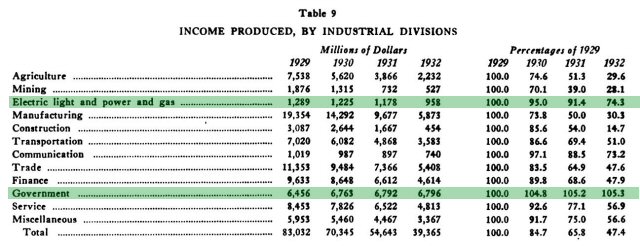Monday, September 07, 2015
This is the stat I was looking for!
Not entirely but close enough. I've noticed for a long time that my direct 'viewports' into the 1930s showed a less disastrous picture than the conventional story. My ancestors got through the Depression without starving or losing their houses. 1940 census data, in cities that I know well, also showed a less dramatic picture.
Here's part of the reason:
 Note the rightmost column, income in 1932 as a percent of 1929. One of my grandpas worked for Detroit Edison (Electric light and power and gas) and the other was a school janitor (Government). They were in the least damaged parts of the economy.
The same book also answers the other half of the question, though not in simple tabular form. Oklahoma depended mainly on cattle and oil. Cattle production didn't drop at all from '29 to '32. Petroleum lost 22%, but the industries typical of the Northeast lost around 70%. So Okla wasn't hurt as badly as the states where media and historians live.
Incidentally, the href'd book is valuable for an odd reason. It's a 10-year collection of newsletters from the National Bureau of Economic Research from 1922 to 1933. Packed with useful and readable info about those years. But how did a book published in 1933 make it past the grasping claws of Steamboat Willie? Because it wasn't exactly published. It appears to have been assembled by a librarian, without a title page to show copyright or publication date. The first page is simply the first newsletter, dated 1922. Just outside Steamboat's well-guarded border.
Note the rightmost column, income in 1932 as a percent of 1929. One of my grandpas worked for Detroit Edison (Electric light and power and gas) and the other was a school janitor (Government). They were in the least damaged parts of the economy.
The same book also answers the other half of the question, though not in simple tabular form. Oklahoma depended mainly on cattle and oil. Cattle production didn't drop at all from '29 to '32. Petroleum lost 22%, but the industries typical of the Northeast lost around 70%. So Okla wasn't hurt as badly as the states where media and historians live.
Incidentally, the href'd book is valuable for an odd reason. It's a 10-year collection of newsletters from the National Bureau of Economic Research from 1922 to 1933. Packed with useful and readable info about those years. But how did a book published in 1933 make it past the grasping claws of Steamboat Willie? Because it wasn't exactly published. It appears to have been assembled by a librarian, without a title page to show copyright or publication date. The first page is simply the first newsletter, dated 1922. Just outside Steamboat's well-guarded border.
 Note the rightmost column, income in 1932 as a percent of 1929. One of my grandpas worked for Detroit Edison (Electric light and power and gas) and the other was a school janitor (Government). They were in the least damaged parts of the economy.
The same book also answers the other half of the question, though not in simple tabular form. Oklahoma depended mainly on cattle and oil. Cattle production didn't drop at all from '29 to '32. Petroleum lost 22%, but the industries typical of the Northeast lost around 70%. So Okla wasn't hurt as badly as the states where media and historians live.
Incidentally, the href'd book is valuable for an odd reason. It's a 10-year collection of newsletters from the National Bureau of Economic Research from 1922 to 1933. Packed with useful and readable info about those years. But how did a book published in 1933 make it past the grasping claws of Steamboat Willie? Because it wasn't exactly published. It appears to have been assembled by a librarian, without a title page to show copyright or publication date. The first page is simply the first newsletter, dated 1922. Just outside Steamboat's well-guarded border.
Note the rightmost column, income in 1932 as a percent of 1929. One of my grandpas worked for Detroit Edison (Electric light and power and gas) and the other was a school janitor (Government). They were in the least damaged parts of the economy.
The same book also answers the other half of the question, though not in simple tabular form. Oklahoma depended mainly on cattle and oil. Cattle production didn't drop at all from '29 to '32. Petroleum lost 22%, but the industries typical of the Northeast lost around 70%. So Okla wasn't hurt as badly as the states where media and historians live.
Incidentally, the href'd book is valuable for an odd reason. It's a 10-year collection of newsletters from the National Bureau of Economic Research from 1922 to 1933. Packed with useful and readable info about those years. But how did a book published in 1933 make it past the grasping claws of Steamboat Willie? Because it wasn't exactly published. It appears to have been assembled by a librarian, without a title page to show copyright or publication date. The first page is simply the first newsletter, dated 1922. Just outside Steamboat's well-guarded border.
